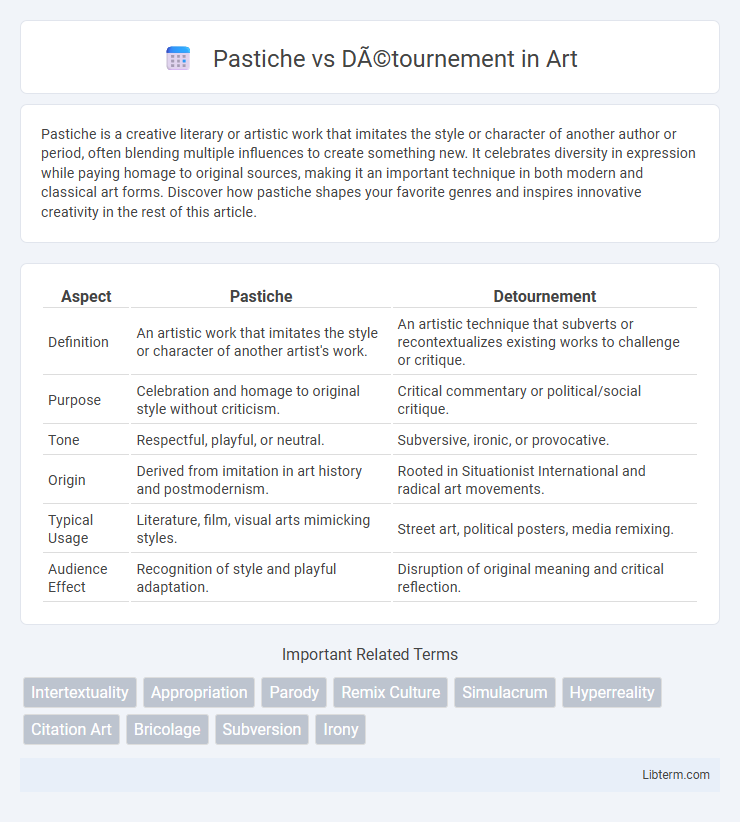Pastiche is a creative literary or artistic work that imitates the style or character of another author or period, often blending multiple influences to create something new. It celebrates diversity in expression while paying homage to original sources, making it an important technique in both modern and classical art forms. Discover how pastiche shapes your favorite genres and inspires innovative creativity in the rest of this article.
Table of Comparison
| Aspect | Pastiche | Detournement |
|---|---|---|
| Definition | An artistic work that imitates the style or character of another artist's work. | An artistic technique that subverts or recontextualizes existing works to challenge or critique. |
| Purpose | Celebration and homage to original style without criticism. | Critical commentary or political/social critique. |
| Tone | Respectful, playful, or neutral. | Subversive, ironic, or provocative. |
| Origin | Derived from imitation in art history and postmodernism. | Rooted in Situationist International and radical art movements. |
| Typical Usage | Literature, film, visual arts mimicking styles. | Street art, political posters, media remixing. |
| Audience Effect | Recognition of style and playful adaptation. | Disruption of original meaning and critical reflection. |
Understanding Pastiche: Definition and Origins
Pastiche is a literary or artistic work that imitates the style or character of another author or period, often created as a respectful homage rather than satire. Originating in the 18th century, pastiche draws on a melange of influences and styles, blending them to celebrate diverse traditions and artistic canons. This form contrasts with detournement, which subverts original works for political or critical purposes rather than honoring them.
What Is Détournement? A Brief Overview
Detournement is an artistic and political technique that involves reusing existing media elements to create new, subversive meanings that challenge dominant cultural narratives. Originating from the Situationist International movement in the 1950s, detournement strategically alters images, texts, or symbols to critique consumerism, capitalism, and mainstream ideology. Unlike pastiche, which often imitates styles without critical intent, detournement disrupts original contexts to provoke reflection and resistance.
Historical Context: From Art Movements to Modern Media
Pastiche originated as a homage to classical art styles during the Renaissance and later became prominent in postmodern art as a technique for imitation and blending of styles without critique, while Detournement emerged in the 1950s from the Situationist International as a revolutionary practice of subverting and recontextualizing existing media to challenge dominant cultural narratives. Pastiche is often associated with postmodernism's playful or nostalgic replication, whereas Detournement serves as a critical tool for political and cultural resistance. Both methods evolved from distinct historical contexts--Renaissance artistic revival for pastiche and mid-20th century anti-capitalist activism for detournement--impacting their applications in contemporary visual arts, film, and digital media.
Key Characteristics of Pastiche
Pastiche is characterized by the imitation or replication of various styles, genres, or authors without critical intent, often serving as an homage or playful tribute. It combines multiple elements from different sources in a way that highlights stylistic features while maintaining a respectful tone toward the originals. Unlike detournement, pastiche lacks subversive or political motives, focusing instead on celebration and stylistic mimicry.
Core Principles of Détournement
Detournement centers on the subversion of existing cultural elements by recontextualizing and altering them to produce new, often oppositional meanings. Its core principles include the appropriation of pre-existing signs, artworks, or texts, combined with a critical and transformative intent that challenges dominant ideologies and capitalist consumption. The technique emphasizes disruption and parody, turning familiar symbols into tools for political critique and social commentary.
Purposes and Intentions: Mimicry vs. Subversion
Pastiche imitates the style or character of another work to celebrate or pay homage without critical intent, often aiming to evoke nostalgia or comedic effect. Detournement repurposes existing cultural elements to subvert or critique the original context, challenging dominant ideologies and provoking critical reflection. The primary purpose of pastiche is mimicry and admiration, whereas detournement is driven by subversion and resistance.
Famous Examples: Pastiche in Literature and Film
Pastiche in literature and film is exemplified by works such as Quentin Tarantino's "Kill Bill," which blends multiple genres and styles to pay homage to classic cinema. Another iconic example is "The Simpsons," which frequently employs pastiche by imitating various cultural and cinematic tropes for comedic effect. These examples showcase how pastiche celebrates and replicates established artistic styles without outright parody, creating new works rooted in recognizable influences.
Iconic Cases of Détournement in Art and Culture
Iconic cases of detournement in art and culture include the works of the Situationist International, such as Guy Debord's reappropriation of advertising imagery to critique consumerism and capitalism. Banksy's street art often exemplifies detournement by subverting familiar cultural icons to convey political messages and social commentary. The practice also appears in the remix culture of music and digital media, where existing cultural artifacts are transformed to challenge dominant narratives and ideologies.
Critical Perspectives: Debates Around Authenticity and Impact
Pastiche mimics styles without critique, often raising debates about originality and cultural value, while detournement subverts existing works to challenge dominant ideologies, emphasizing political engagement and authenticity. Critics argue pastiche risks superficiality and commodification, whereas detournement is praised for its transformative impact and resistance to cultural hegemony. These competing practices fuel ongoing discussions about the role of appropriation in art's social and ethical dimensions.
Pastiche and Détournement Today: Relevance in Contemporary Creativity
Pastiche and Detournement remain pivotal in contemporary creativity, with pastiche celebrated for its homage through stylistic imitation, while detournement subverts original meanings to critique culture and power structures. Modern artists and designers harness pastiche to evoke nostalgia and intertextuality, whereas detournement fuels provocative art that challenges consumerism and mainstream narratives. These opposing yet complementary techniques shape dialogues in digital art, advertising, and political activism today.
Pastiche Infographic

 libterm.com
libterm.com